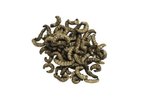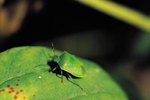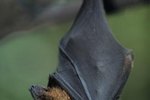
Around 1900, three species of mole crickets were introduced to the southeastern United States. These insects are flightless, thus they are restricted mostly to their initial origin; although some have been redistributed north and west. Mole crickets undergo simple metamorphosis consisting of three developmental phases: egg, nymph and adult.
Description
The life cycle of a mole cricket begins in late spring when eggs are produced and ends in early fall when the insect reaches adult stage. One generation produced per year is normal. However, in warmer climates such as southern Florida, mole crickets are able to produce eggs throughout the year, allowing for two generations. Since mole crickets are soil insects who tunnel for shelter and breeding, they often disturb plant life as adults.
Eggs
Mole crickets dig a 3- to 4-centimeter-long by 3- to 4-centimeter-deep channel into their soil tunnel in preparation for egg storage. In late spring and early summer, mole cricket females lay their clusters of eggs, depositing typically 25 to 60 eggs, each female producing four to five clutches per spring. These brown- to grey-colored eggs are bean-shaped, measuring 3 millimeters in length. Mole crickets are in their egg stage for no more than 40 days.
Nymphs
After hatching, the mole crickets are in their nymph phase of metamorphosis. Nymphs resemble adult mole crickets with less-developed wings. Immediately after hatching from their eggs, mole crickets are white; they gradually change to dark brown after 24 hours. They typically go through eight periods of shedding as they grow. For sustenance, nymphs feed on their own egg shell or cannibalize nearby siblings. As the sun goes down, nymph mole crickets dig up through the soil to surface and forage. This stage of the mole cricket life cycle lasts approximately four months, from July to October.
Adults
After six months of growth during the egg and nymph stage, mole crickets reach their adult stage. Adult mole crickets grow upward of an inch and a half. Appendages of adult mole crickets are fully developed, especially the front legs; since they are used for digging tunnels in soil. Females do not have ovipositors. At night, males produce mating songs to attract females into their burrows in hopes of starting the life cycle over again. Mole crickets typically live no more than one year, with males dying soon after mating and females dying soon after laying eggs.
References
Photo Credits
-
FPG/Retrofile/Getty Images
Writer Bio
Amanda Williams has been writing since 2009 on various writing websites and blogging since 2003. She enjoys writing about health, medicine, education and home and garden topics. Williams earned a Bachelor of Science in biology at East Stroudsburg University in May 2013. Williams is also a certified emergency medical technician.



